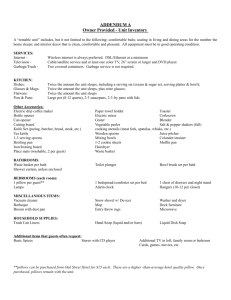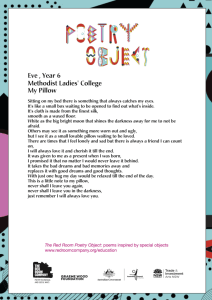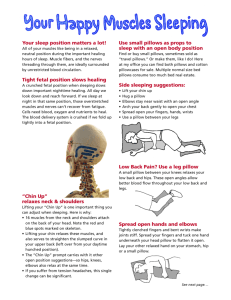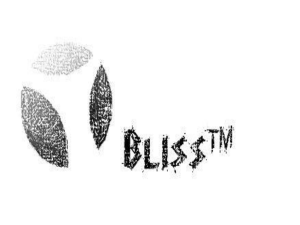Buylines for Bedding and Bath Towels
advertisement
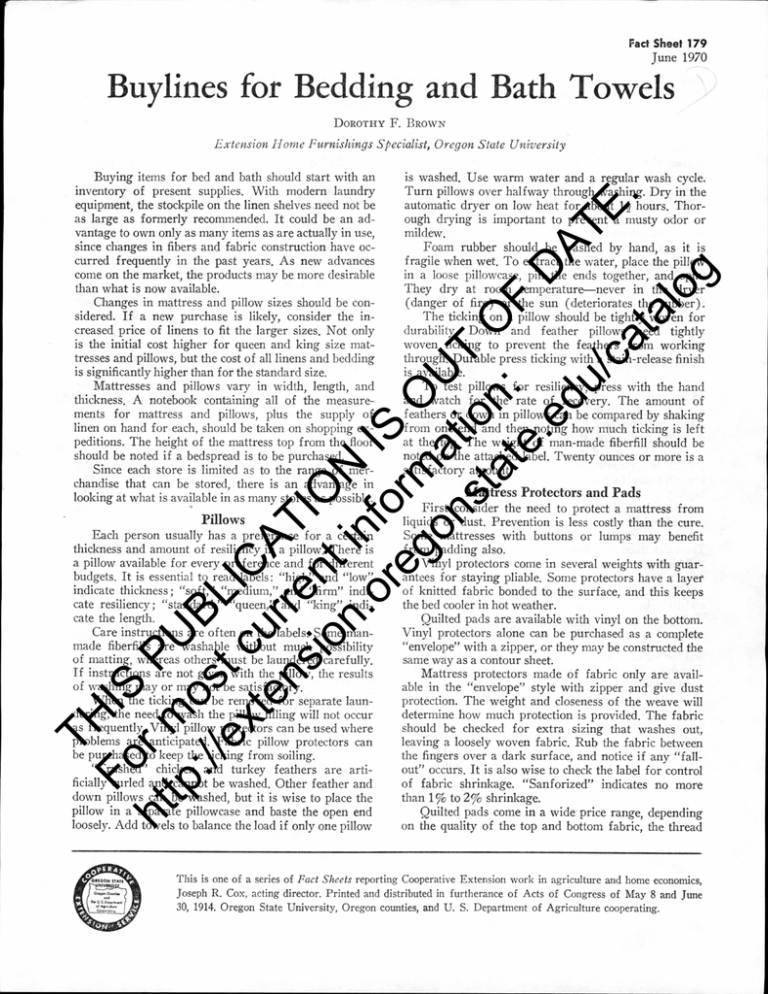
Fact Sheet 179 June 1970 Buylines for Bedding and Bath Towels DOROTHY F. BROWN - Extension Home Furnishings Specialist, Oregon State University is washed. Use warm water and a regular wash cycle. Turn pillows over halfway through washing. Dry in the automatic dryer on low heat for about 1i hours. Thorough drying is important to prevent a musty odor or Fo IS ht r m P U tp :// os BL ex t c IC te ur A ns re TI io nt ON n. in or fo IS eg rm O on at U st ion T O at : F e. D ed A u/ TE ca . ta lo g Buying items for bed and bath should start with an inventory of present supplies. With modern laundry equipment, the stockpile on the linen shelves need not be as large as formerly recommended. It could be an ad- vantage to own only as many items as are actually in use, since changes in fibers and fabric construction have oc- mildew. curred frequently in the past years. As new advances fragile when wet. To extract the water, place the pillow in a loose pillowcase, pin the ends together, and spin. come on the market, the products may be more desirable than what is now available. Changes in mattress and pillow sizes should be con- Foam rubber should be washed by hand, as it is They dry at room temperaturenever in the dryer (danger of fire) or the sun (deteriorates the rubber). sidered. If a new purchase is likely, consider the increased price of linens to fit the larger sizes. Not only is the initial cost higher for queen and king size mat- durability. Down and feather pillows need tightly woven ticking to prevent the feathers from working tresses and pillows, but the cost of all linens and bedding is significantly higher than for the standard size. through. Durable press ticking with a stain-release finish is available. Mattresses and pillows vary in width, length, and thickness. A notebook containing all of the measure- To test pillows for resiliency, press with the hand and watch for the rate of recovery. The amount of ments for mattress and pillows, plus the supply of linen on hand for each, should be taken on shopping expeditions. The height of the mattress top from the floor should be noted if a bedspread is to be purchased. Since each store is limited as to the range of merchandise that can be stored, there is an advantage in looking at what is available in as many stores as possible. Pillows Each person usually has a preference for a certain thickness and amount of resiliency in a pillow. There is a pillow available for every preference and for different budgets. It is essential to read labels: "high" and "low" indicate thickness ; "soft," "medium," and "firm" indicate resiliency; "standard," "queen," and "king" indi- TH cate the length. Care instructions are often on the labels. Some manmade fiberfills are washable without much possibility of matting, whereas others must be laundered carefully. If instructions are not given with the pillow, the results of washing may or may not be satisfactory. When the ticking can be removed for separate laundering, the need to wash the pillow filling will not occur as frequently. Vinyl pillow protectors can be used where problems are anticipated. Fabric pillow protectors can be purchased to keep the ticking from soiling. "Crushed" chicken and turkey feathers are arti- ficially curled and cannot be washed. Other feather and down pillows can be washed, but it is wise to place the pillow in a separate pillowcase and baste the open end loosely. Add towels to balance the load if only one pillow Greg. The ticking on a pillow should be tightly woven for feathers or down in pillows can be compared by shaking from one end and then noting how much ticking is left at the top. The weight of man-made fiberfill should be noted on the attached label. Twenty ounces or more is a satisfactory amount. Mattress Protectors and Pads First consider the need to protect a mattress from liquids or dust. Prevention is less costly than the cure. Some mattresses with buttons or lumps may benefit from padding also. Vinyl protectors come in several weights with guarantees for staying pliable. Some protectors have a layer of knitted fabric bonded to the surface, and this keeps the bed cooler in hot weather. Quilted pads are available with vinyl on the bottom. Vinyl protectors alone can be purchased as a complete "envelope" with a zipper, or they may be constructed the same way as a contour sheet. Mattress protectors made of fabric only are available in the "envelope" style with zipper and give dust protection. The weight and closeness of the weave will determine how much protection is provided. The fabric should be checked for extra sizing that washes out, leaving a loosely woven fabric. Rub the fabric between the fingers over a dark surface, and notice if any "fallout" occurs. It is also wise to check the label for control of fabric shrinkage. "Sanforized" indicates no more than 1% to 2% shrinkage. Quilted pads come in a wide price range, depending on the quality of the top and bottom fabric, the thread This is one of a series of Fact Sheets reporting Cooperative Extension work in agriculture and home economics, Joseph R. Cox, acting director. Printed and distributed in furtherance of Acts of Congress of May 8 and June 30, 1914. Oregon State University, Oregon counties, and U. S. Department of Agriculture cooperating. used for quilting (nylon is strongest), and the amount and quality of the filling. Some pads have elastic anchor bands at the corners, others have skirts that are shaped to fit under the mattress. The labels on mattress pads give information about laundering, whether a dryer can be used, drying time, expected shrinkage, and control to keep the filling from shifting and lumping. Quilted pads provide some protection from buttons and lumps air in the loose, open mesh. Some thermal weave blankets also are napped for extra warmth. A covering may be used over these blankets to hold in the trapped air when real warmth is desired. In the summer the covering can Fo IS ht r m P U tp :// os BL ex t c IC te ur A ns re TI io nt ON n. in or fo IS eg rm O on at U st ion T O at : F e. D ed A u/ TE ca . ta lo g in the mattress. rather how much of the fiber is in the nap. Wool, acrylic, and polyester fibers are the most satisfactory in retaining a deep nap. Labels give information about special finishes that prevent shedding and pilling. Wool blankets are generally mothproofed. A special construction called a "thermal weave" traps Mattress "toppers" add softness to a mattress and smooth out lumps. They are made of polyurethane foam or a combination of polyurethane and foam rubber. If a vinyl mattress protector is used underneath a foam topper, place a sheet over the vinyl to keep the topper from bunching up on the slick surface of the plastic. The foam is not a protector since liquid will go right through it. Polyurethane foam can be washed in a laundry tub and dried in a dryer, but foam rubber cannot go in a dryer or be exposed to sunlight. Sheets and Pillowcases The most popular sheets are durable press, both in percale and muslin. The percale is made from a finer cotton yarn and therefore feels softer and more luxurious. Both the durable press percale and muslin combine cotton and polyester fibers. Although these sheets cost more than all-cotton sheets, they also last longer. The thread count for a durable muslin is 128 to 140, for a percale is approximately 180. Since all-cotton sheets are still available, read the labels to be sure what you are buying. There is a price increase from white to plain color to printed and from twin on up to king size. Pillowcases are available to match all of the sheets. The most common pillowcase sizes are standard, queen, and king. To determine the size of pillowcase needed for other pillows, measure the width all the way around and add 2 inches. Then measure the length of the pillow and add 10 inches. Blankets and Quilts The usual blanket construction traps air in the fibers, and the air acts as an insulator to hold in body warmth. The fluffy fibers in the quilt filling do the same thing. Electric blankets actually add heat, as well as holding in body heat. Shoppers need to be concerned with how well TH the blanket or quilt construction will trap air, and whether laundering the covering will change construction. With electric blankets, consider the flexibility and quality of the controls (and length of guarantee). Napped blankets are as warm as the nap is deep and dense. The kind of fiber is not the important factor, but be removed so the blanket will be less warm. All thermal weave blankets stretch some in use, but rayon and cotton stretch the most. In laundering, the polyester and acrylic blankets stretch the least. Stretching is reduced when thermal blankets are dried in an automatic dryer. Flocked blankets are becoming very popular. Nylon fibers are bonded "on end" to both sides of a thin layer of polyurethane foam. The result is a very lightweight, warm, washable blanket with a velvety surface. Quilts can be used both as a cover and as a bed- spread, if a dust ruffle is used. Check the length of the quilt to determine if it will cover the pillows, or if separate pillow shams will be needed. The cover and filling fibers vary, so check the care instructions on the label. Quilts that can be zipped up into sleeping bags are available, with carrying bags included. Towels Check towel construction by holding towels up to the light and comparing how much can be seen through the fabric. The more yarns that are used the greater the absorbency of moisture should be. However, many towels have the terry loops sheared on one side, because fabric dyes take better when the loops are cut. However, the sheared terry does not absorb water as well as the loops, so the looped side is best for drying. Towels with lovely, deep colors need to be washed alone in lukewarm water to keep their beauty. The edges of towels vary ; selvages are used on some, whereas others have the selvages turned over and stitched. The turned-and-stitched selvage will not tear as easily as the plain selvage edges. When a different weave is used as a band, towel borders sometimes pucker up in the laundry and cause a ruffle at either end of the towel. To prevent this, buy towels that are guaranteed to have "unpuckered borders." One way to save money is to look for sales where towels are sold at less price because of small flaws. These "seconds" are frequently perfectly satisfactory, but can- not be sold as first quality because of slight imperfections.
